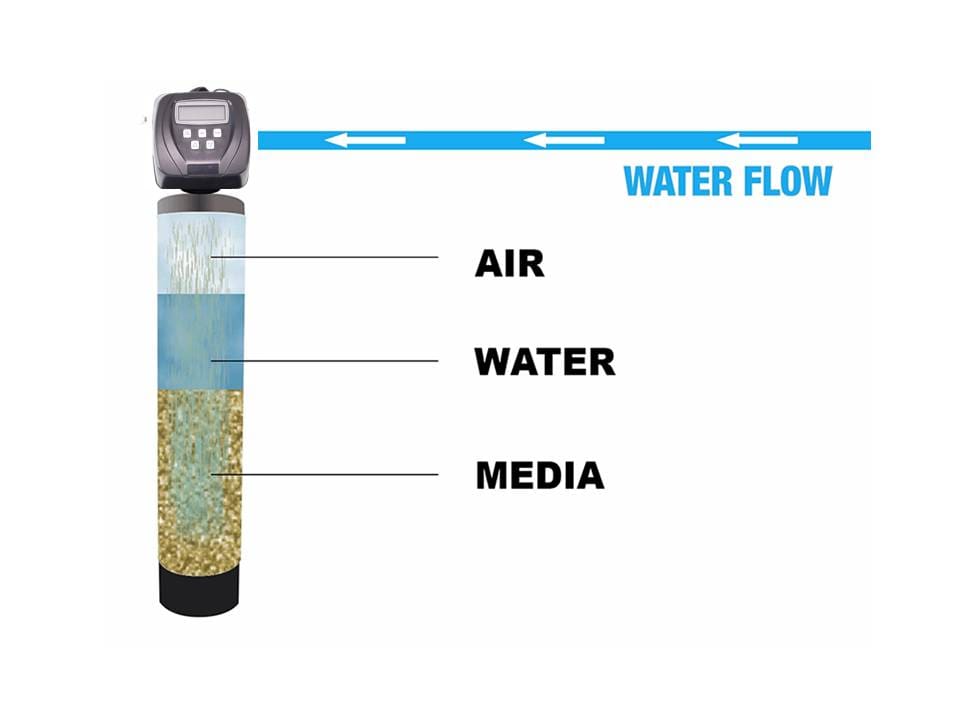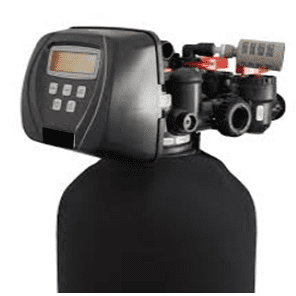Iron Filter/Manganese/H2S Filter
- Home
- Iron Filter/Manganese/H2S Filter
Clack Chemical Free Sulphur/Iron Filter
Why A Chemical Free Iron Filter?
- Perfect if want to solve your sulphur/iron problem with the least amount of on-going expense.
- Power cell backup to retain settings and time during power interruptions so you don’t need to reset the clock.
- Chemical Free System – much friendlier on your septic system compared to Greensand chemical iron filters.
- Includes air injection system as an oxidizer so there is no need for any expensive ozone generator
- Removes up to 4 ppm sulphur and 10 ppm iron, you get two filters in one!
- Fully compatible with Constant Pressure and Jet Pumps
- Available from 1 cubic foot up to 3 cubic feet for commercial applications
- Whole House Filter
- Fully Automatic system
- Bypass Valve included
- Electronically Controlled Valve
- Clack Water Treatment Valves used exclusively
- Tech can disassemble Valve in 5 minutes, for easy service to save your family money
- Our Valves use no nuts, bolts, screws or springs so they are easier to service

Affordable Water Whole House Iron Water Filters
Finding the Right Iron Filter
Iron comes in many different forms, some are visible and some are dissolved in the groundwater and is not readily noticeable by the naked eye. When it comes to water treatment iron is a complex element, and each form of the iron is removed somewhat differently. Total Iron refers to all the iron in your water but what most lab tests won’t tell you is what kinds of iron you have, and how much of each kind of iron is present in the water. When Affordable Water Treatments does a water test for iron we like to be on the site to observe different areas, to determine the different kinds of iron you have.
Ferrous Iron
We have three main types of iron we find in Manitoba. The first type is called Ferrous iron and is totally dissolved in the water. This iron is also referred to as clear water iron. In order to see this iron we must oxidize the water and the iron will turn an orange color. We have a gauge that we use where we can match the color of your iron to a colour chart to determine how much Ferrous iron you have.
If you run a bath and the water runs out clear, but after a couple of hours turns to an orange color, you most likely have Ferrous iron / clear water iron. It is a naturally occurring mineral that is present in the majority of wells in Manitoba. The iron is measured in Parts Per Million (PPM) which refers to the amount of Total Dissolved solids (TDS) of iron you have in your water. In amounts of 0.3 (PPM), it is relatively harmless and you won’t notice it much. When you get over that amount it begins to leave reddish-brown staining in your toilets, washing machines, dishwasher, and you may even notice orange highlights in your hair, if it is light-colored. The damage it does to your plumbing is not seen often untill it is too late. Iron will build up in your pipes, hot water tanks, and gather in the water softener clogging it up so it does not work anymore. At that point, you start to see limescale buildup along with the iron staining and it can become a real nightmare for some folks.
Ferric Iron
Ferric iron is not as subtle as ferrous iron in that it lets you know it is there right away. The water will look orange or a little on the brown side coming right out of the tap. This form of iron is not dissolved in the water and is easily seen by the naked eye. It will also stain your toilets and sinks and most of your water appliances, but the real damage is the buildup of iron in your plumbing is much faster and more pronounced as a rule. The chance of this iron clogging up your pipes if left unchecked is much higher than ferrous iron, however, both forms of iron pose a threat.
Iron Bacteria
Iron Bacteria Can Impact Your Home’s Water Quality. If you’ve noticed a strange smell or discolored water coming from your taps, there’s a good chance that iron bacteria could be to blame. These tiny organisms thrive in environments with high levels of iron, causing an array of water quality issues that can be a real headache for homeowners. Iron bacteria are often off the radar for water quality concerns. However, their presence can lead to foul odors, slimy build-up, and even clogged pipes. These bacteria feed on iron and manganese, forming a reddish-brown slime known as iron ochre. This slime can accumulate inside pipes, clogging plumbing systems and reducing water pressure. Not only do iron bacteria cause aesthetic issues, but they can also affect the efficiency and longevity of your plumbing system. Moreover, some iron bacteria can produce corrosive byproducts that can damage fixtures and appliances. To ensure the health and functionality of your home’s water supply, it’s essential to understand the impact of iron bacteria and take proactive measures to combat it. An iron remover often referred to as an iron filter will take out the iron in your water which leads to the growth of these unseen culprits so they will not compromise your home’s water quality any longer!
Chemical-free Iron Filter
Affordable Water chooses to use a system that is environmentally friendly to remove the iron from the water. We don’t introduce harsh or poisonous chemicals into the water to help remove the iron, except in extreme cases where we have no choice. We remove the iron rather than add chemicals that end up in the groundwater over time and further pollute the environment.
The system that we use is called an AIO iron filter also known as a Chemical-free Iron Filter. This system uses a compressed air pocket to oxidize the water bringing the dissolved iron to a solid form where it can be trapped in the media and flushed out into the sewer, instead of running through your home.
One of the advantages of using a Chemical-free Iron Filter is it also oxidizes the hydrogen sulfide gas which is in the water as a result of the iron breaking down in the groundwater.. The hydrogen sulfide gas (H2S) smells a little like rotten eggs when you run your water out of the tap. By oxidizing the H2S it will also turn into a solid and be trapped in the media as well taking the smell out of your water.
The media in the iron filter is also engineered to remove manganese which is almost always found with iron and causes black staining in your sinks and toilets. So after the water has been run through the Iron Filter you will have removed not just iron, but H2S and manganese as well. This is why this filter system is referred to as a three-in-one system.
The system regenerates itself every 3 to 5 days depending on your water usage and has very little maintenance except to check it every couple of years. The media bed should last you 7 to 10 years before it has to be replaced, but the valve can be cleaned and used again.
If you are experiencing a problem with staining or stinky water let the experts at Affordable Water Treatment do a water test and let you know what options are available to you.


